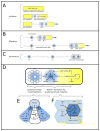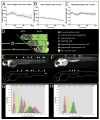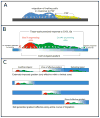A framework for understanding morphogenesis and migration of the zebrafish posterior Lateral Line primordium
- PMID: 28460893
- PMCID: PMC10993927
- DOI: 10.1016/j.mod.2017.04.005
A framework for understanding morphogenesis and migration of the zebrafish posterior Lateral Line primordium
Abstract
A description of zebrafish posterior Lateral Line (pLL) primordium development at single cell resolution together with the dynamics of Wnt, FGF, Notch and chemokine signaling in this system has allowed us to develop a framework to understand the self-organization of cell fate, morphogenesis and migration during its early development. The pLL primordium migrates under the skin, from near the ear to the tip of the tail, periodically depositing neuromasts. Nascent neuromasts, or protoneuromasts, form sequentially within the migrating primordium, mature, and are deposited from its trailing end. Initially broad Wnt signaling inhibits protoneuromast formation. However, protoneuromasts form sequentially in response to FGF signaling, starting from the trailing end, in the wake of a progressively shrinking Wnt system. While proliferation adds to the number of cells, the migrating primordium progressively shrinks as its trailing cells stop moving and are deposited. As it shrinks, the length of the migrating primordium correlates with the length of the leading Wnt system. Based on these observations we show how measuring the rate at which the Wnt system shrinks, the proliferation rate, the initial size of the primordium, its speed, and a few additional parameters allows us to predict the pattern of neuromast formation and deposition by the migrating primordium in both wild-type and mutant contexts. While the mechanism that links the length of the leading Wnt system to that of the primordium remains unclear, we discuss how it might be determined by access to factors produced in the leading Wnt active zone that are required for collective migration of trailing cells. We conclude by reviewing how FGFs, produced in response to Wnt signaling in leading cells, help determine collective migration of trailing cells, while a polarized response to a self-generated chemokine gradient serves as an efficient mechanism to steer primordium migration along its relatively long journey.
Published by Elsevier B.V.
Figures




Similar articles
-
Cxcl12a induces snail1b expression to initiate collective migration and sequential Fgf-dependent neuromast formation in the zebrafish posterior lateral line primordium.Development. 2018 Jul 30;145(14):dev162453. doi: 10.1242/dev.162453. Development. 2018. PMID: 29945870 Free PMC article.
-
SoxB1 family members inhibit Wnt signaling to promote maturation and deposition of stable neuromasts by the zebrafish Posterior Lateral Line primordium.bioRxiv [Preprint]. 2025 Apr 26:2025.04.23.650055. doi: 10.1101/2025.04.23.650055. bioRxiv. 2025. PMID: 40568083 Free PMC article. Preprint.
-
NetLogo agent-based models as tools for understanding the self-organization of cell fate, morphogenesis and collective migration of the zebrafish posterior Lateral Line primordium.Semin Cell Dev Biol. 2020 Apr;100:186-198. doi: 10.1016/j.semcdb.2019.12.015. Epub 2019 Dec 31. Semin Cell Dev Biol. 2020. PMID: 31901312 Review.
-
In toto imaging of the migrating Zebrafish lateral line primordium at single cell resolution.Dev Biol. 2017 Feb 1;422(1):14-23. doi: 10.1016/j.ydbio.2016.12.015. Epub 2016 Dec 11. Dev Biol. 2017. PMID: 27965055
-
Cell-cell signaling interactions coordinate multiple cell behaviors that drive morphogenesis of the lateral line.Cell Adh Migr. 2011 Nov-Dec;5(6):499-508. doi: 10.4161/cam.5.6.19113. Cell Adh Migr. 2011. PMID: 22274715 Free PMC article. Review.
Cited by
-
An evolutionary and physiological perspective on cell-substrate adhesion machinery for cell migration.Front Cell Dev Biol. 2022 Aug 25;10:943606. doi: 10.3389/fcell.2022.943606. eCollection 2022. Front Cell Dev Biol. 2022. PMID: 36092727 Free PMC article. Review.
-
CXCL12 and MYC control energy metabolism to support adaptive responses after kidney injury.Nat Commun. 2018 Sep 10;9(1):3660. doi: 10.1038/s41467-018-06094-4. Nat Commun. 2018. PMID: 30202007 Free PMC article.
-
Cell interactions in collective cell migration.Development. 2019 Dec 5;146(23):dev172056. doi: 10.1242/dev.172056. Development. 2019. PMID: 31806626 Free PMC article. Review.
-
Confocal Microscope-Based Laser Ablation and Regeneration Assay in Zebrafish Interneuromast Cells.J Vis Exp. 2020 May 20;(159):10.3791/60966. doi: 10.3791/60966. J Vis Exp. 2020. PMID: 32510477 Free PMC article.
-
Apical contacts stemming from incomplete delamination guide progenitor cell allocation through a dragging mechanism.Elife. 2021 Aug 27;10:e66483. doi: 10.7554/eLife.66483. Elife. 2021. PMID: 34448451 Free PMC article.
References
-
- Aman A, Nguyen M, Piotrowski T. Wnt/beta-catenin dependent cell proliferation underlies segmented lateral line morphogenesis. Dev Biol. 2011;349:470–82. - PubMed
-
- Aman A, Piotrowski T. Wnt/beta-catenin and Fgf signaling control collective cell migration by restricting chemokine receptor expression. Dev Cell. 2008;15:749–61. - PubMed
-
- Bleckmann H, Zelick R. Lateral line system of fish. Integr Zool. 2009;4:13–25. - PubMed
-
- Boldajipour B, Mahabaleshwar H, Kardash E, Reichman-Fried M, Blaser H, Minina S, Wilson D, Xu Q, Raz E. Control of chemokine-guided cell migration by ligand sequestration. Cell. 2008;132:463–73. - PubMed
Publication types
MeSH terms
Substances
Grants and funding
LinkOut - more resources
Full Text Sources
Other Literature Sources
Research Materials

